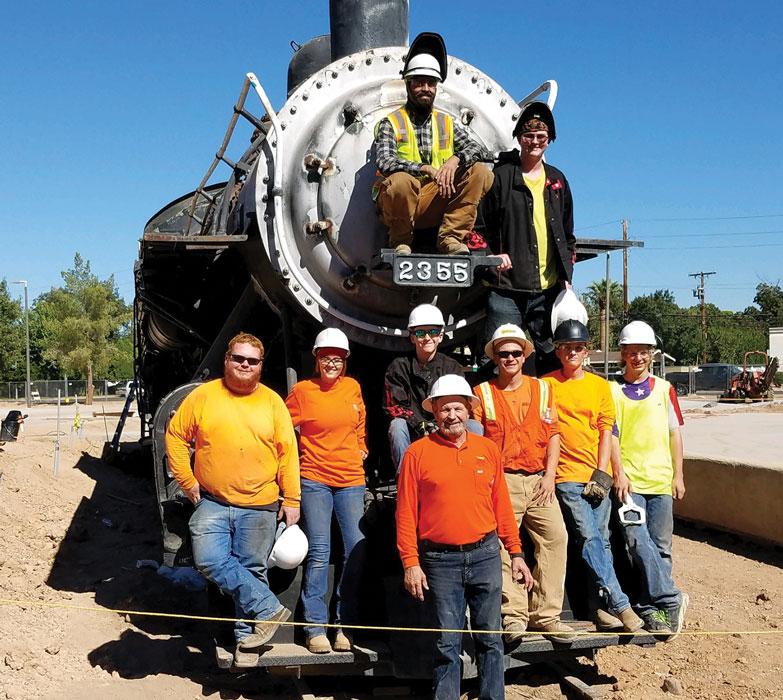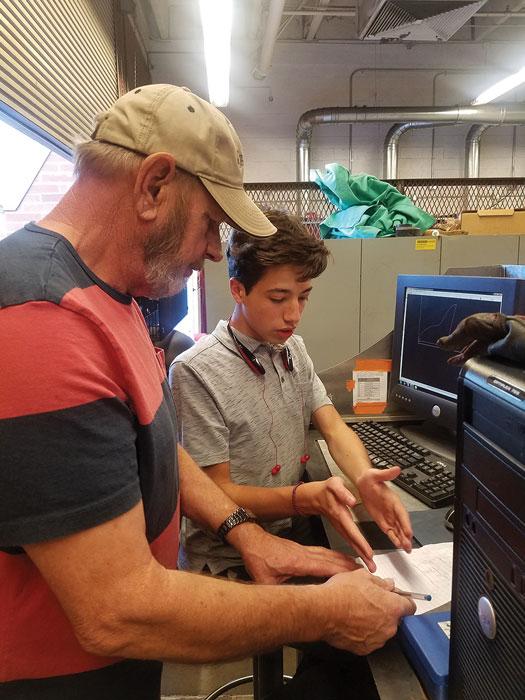- FMA
- The Fabricator
- FABTECH
- Canadian Metalworking
Categories
- Additive Manufacturing
- Aluminum Welding
- Arc Welding
- Assembly and Joining
- Automation and Robotics
- Bending and Forming
- Consumables
- Cutting and Weld Prep
- Electric Vehicles
- En Español
- Finishing
- Hydroforming
- Laser Cutting
- Laser Welding
- Machining
- Manufacturing Software
- Materials Handling
- Metals/Materials
- Oxyfuel Cutting
- Plasma Cutting
- Power Tools
- Punching and Other Holemaking
- Roll Forming
- Safety
- Sawing
- Shearing
- Shop Management
- Testing and Measuring
- Tube and Pipe Fabrication
- Tube and Pipe Production
- Waterjet Cutting
Industry Directory
Webcasts
Podcasts
FAB 40
Advertise
Subscribe
Account Login
Search
Students help to revive Mesa’s Engine No. 2355
City icon refurbished for a new generation to enjoy
- By Kate Youdell
- December 7, 2018
- Article
- Arc Welding

Figure 1
Volunteers who provided some of the welding and fabricating services for the restoration of locomotive No. 2355 in Mesa, Ariz., pose with their rehab subject. Photo courtesy of Dan Hurst.
For the city of Mesa, Ariz., an aged locomotive sitting in Pioneer Park is anything but a forgotten piece of the past.
“The train is an icon for the city,” said Dan Hurst, career and technical education welding teacher at Mesa’s Red Mountain High School. “It has a lot of sentimental value for a lot of residents.”
Hurst especially feels connected to the engine, as it has resided in Pioneer Park since he was a child.
Steam locomotive No. 2355, built for the Southern Pacific Railroad in October 1912 by Baldwin Locomotive Works in Philadelphia, is one of two T-31 engines left in the world. (The other is located in Campo, Calif.) The engine was built as a dual-service locomotive for smaller passenger and freight trains.
No. 2355 operated several million miles during its 45 years of service. It met the end of its useful life when Southern Pacific and other railroads were converting to diesel power. The railroad retired the locomotive in late 1957, and it avoided the scrap heap when it was given to the Mesa community on April 12, 1958.
Toward the end of 2017 the restoration of the engine became the project of Red Mountain High School welding students, Mesa’s Save Our Train Committee, and other community volunteers (see Figure 1). Several local businesses assisted as well with in-kind contributions and the donation of their time.
Hurst organized welding activities for the two-month-long project, coordinating students from the high school and Mesa Community College to help them gain experience in the welding field and give them an opportunity to serve their community.
“I try to provide as many opportunities as possible to volunteer,” Hurst said.
Hurst said the students (see Figure 2) used a variety of welding processes for the restoration project, including gas metal arc, shielded metal arc, plasma, and oxyfuel welding, in addition to using CNC programs to manufacture any replacement parts the engine may need. The repairs included installing new stairs up to the engine (see Figure 3), repairing the elevated platform where visitors can stand to get a closer look of the engine, and refurbishing the engine’s bell and whistle. In addition to Hurst, his crew of students, and volunteers, local manufacturers also contributed to the restoration project, which was mostly financed by community donations.
Red Mountain High School is one of six high schools within the Mesa Public School District. Each of those high schools offers career and technical education programs, including a welding curriculum. Graduates from these high schools often go to Mesa Community College, Hurst said, where they can continue pursuing a career in welding or other technical trades. Hurst said employers prize job candidates that have some experience, so he works to find opportunities for the welding students to put their skills to use while they are learning their craft.

Figure 2
The Red Mountain High School welding students approached the train restoration project like a shop might approach a job. For instance, the students had to consult blueprints before beginning to weld. Photo courtesy of Tim Hacker.
Those same welding students can point to the Baldwin Engine No. 2355 as an example of some of their early work. Thanks to their efforts, the train will be around for many more generations to enjoy and remain an important link to Mesa’s past.
Mesa Public Schools, www.mpsaz.org
About the Author

About the Publication
subscribe now

The Welder, formerly known as Practical Welding Today, is a showcase of the real people who make the products we use and work with every day. This magazine has served the welding community in North America well for more than 20 years.
start your free subscription- Stay connected from anywhere

Easily access valuable industry resources now with full access to the digital edition of The Fabricator.

Easily access valuable industry resources now with full access to the digital edition of The Welder.

Easily access valuable industry resources now with full access to the digital edition of The Tube and Pipe Journal.
- Podcasting
- Podcast:
- The Fabricator Podcast
- Published:
- 04/16/2024
- Running Time:
- 63:29
In this episode of The Fabricator Podcast, Caleb Chamberlain, co-founder and CEO of OSH Cut, discusses his company’s...
- Trending Articles
Sheffield Forgemasters makes global leap in welding technology

ESAB unveils Texas facility renovation

Engine-driven welding machines include integrated air compressors

How welders can stay safe during grinding

The impact of sine and square waves in aluminum AC welding, Part I

- Industry Events
16th Annual Safety Conference
- April 30 - May 1, 2024
- Elgin,
Pipe and Tube Conference
- May 21 - 22, 2024
- Omaha, NE
World-Class Roll Forming Workshop
- June 5 - 6, 2024
- Louisville, KY
Advanced Laser Application Workshop
- June 25 - 27, 2024
- Novi, MI



























